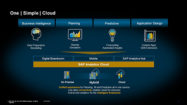SAP Cloud Migration
Filter By
Browse By
- SAP Analytics and AI
- SAP Application Development and Integration
- All SAP Application Development and Integration
- SAP ABAP
- SAP ABAP Development Tools
- SAP ABAP Test Cockpit
- SAP API Management
- SAP BAPI
- SAP Basis
- SAP BRF
- SAP Business Application Studio
- SAP CMS
- SAP Design Studio
- SAP Development Tools
- SAP DevOps
- SAP EAI
- SAP EDI
- SAP Extension Suite
- SAP Fiori
- SAP Fiori Elements
- SAP Integration Suite
- SAP Low Code Application Development
- SAP Low Code Automation
- SAP Netweaver
- SAP Release Management
- SAP UI5
- SAP Web Application Server
- SAP Web IDE
- SAP Business Process Management
- SAP Center of Excellence
- SAP CIO
- SAP Customer Experience
- SAP Data and Data Management
- All SAP Data and Data Management
- SAP BW
- SAP BW/4HANA
- SAP Crystal Reports
- SAP Data Archiving
- SAP Data Center
- SAP Data Governance
- SAP Data Integration
- SAP Data Migration
- SAP Data Quality
- SAP Data Services
- SAP Data Strategy
- SAP Data Visualization
- SAP Data Warehouse Cloud
- SAP DMS
- SAP Document Control
- SAP EIM
- SAP ETL
- SAP ETL Tools
- SAP HANA
- SAP HANA Administration
- SAP HANA Deployment Infrastructure
- SAP HANA Studio
- SAP Master Data
- SAP Master Data Governance
- SAP MDM
- SAP Enterprise Architect
- SAP Enterprise Asset Management
- SAP ERP
- SAP Finance
- All SAP Finance
- SAP Accounting
- SAP AR AP
- SAP Asset Accounting
- SAP Billing Systems
- SAP BPC
- SAP BRIM
- SAP Cash Management
- SAP Central Finance
- SAP Controlling
- SAP COPA
- SAP Cost Center Accounting
- SAP e-invoicing
- SAP FICO
- SAP Finance Automation
- SAP Financial Closing Cockpit
- SAP Financial Consolidation
- SAP Financial Planning
- SAP FX Risk
- SAP General Ledger
- SAP Global Tax Management
- SAP Hyperion
- SAP Order to Cash
- SAP Payment Processing
- SAP Profitability Analysis
- SAP Rebate Management
- SAP S/4HANA Finance
- SAP Universal Journal
- SAP Governance Risk and Compliance
- SAP Human Capital Management
- SAP Intelligent Technologies
- SAP Platform and Technology
- All SAP Platform and Technology
- SAP Business Technology Platform
- SAP Cloud Connector
- SAP Cloud Integration Platform
- SAP Cloud Migration
- SAP Cloud Platform
- SAP Cloud Providers
- SAP Cloud Strategy
- SAP Container Platform
- SAP Digital Asset Management
- SAP Digital Integration Hub
- SAP Digital Signature
- SAP HANA Enterprise Cloud
- SAP HEC
- SAP Hyperscalers
- SAP Infrastructure
- SAP Messaging
- SAP Smart Forms
- SAP Quality and Testing
- SAP Security
- SAP Spend Management
- SAP Supply Chain Management
- All SAP Supply Chain Management
- SAP APO
- SAP Asset Management
- SAP Business Network
- SAP Digital Manufacturing Cloud
- SAP Digital Twin
- SAP EWM
- SAP IBP
- SAP Inventory Management
- SAP Label Printing
- SAP Logistics
- SAP Manufacturing
- SAP Manufacturing Automation
- SAP MES
- SAP MII
- SAP MM
- SAP MRO
- SAP MRP
- SAP Order Management
- SAP Plant Maintenance
- SAP PLM
- SAP Production Planning
- SAP S&OP
- SAP SD
- SAP SPM
- SAP Supply Chain Planning
- SAP Track and Trace
- SAP Transportation Management
- SAP System Administration
What is SAP Cloud Migration?
Moving to the cloud has become increasingly critical for SAPinsiders today as they look to replace existing hardware and infrastructure that no longer delivers the required performance. Initial moves to the cloud were largely focused on putting in place infrastructure that provided more flexibility and scalability while being able to deploy systems more quickly. Today’s SAP Cloud Migration involves integrating SAP and non-SAP systems, architecture redesign, hybrid cloud environments, and multiple cloud providers. Today’s cloud migration focus is also on increasing security while managing cost. These two requirements were the most important in 2021 research conducted by SAPinsider on moving SAP workloads to the cloud and continue to be crucial for organizations planning for long-term cloud success.
What is SAP Cloud Migration?
Moving to the cloud has become increasingly critical for SAPinsiders today as they look to replace existing hardware and infrastructure that no longer delivers the required performance. Initial moves to the cloud were largely focused on putting in place infrastructure that provided more flexibility and scalability while being able to deploy systems more quickly. Today’s SAP Cloud Migration involves integrating SAP and non-SAP systems, architecture redesign, hybrid cloud environments, and multiple cloud providers. Today’s cloud migration focus is also on increasing security while managing cost. These two requirements were the most important in 2021 research conducted by SAPinsider on moving SAP workloads to the cloud and continue to be crucial for organizations planning for long-term cloud success.
Key Considerations for SAPinsiders:
- Spend time understanding whether your SAP Cloud Migration concerns are valid. Many organizations have concerns about challenges with moving to the cloud. These include topics such as cost, security, availability, performance, and the complexity of integration. But some of the concerns may be misconceptions. Taking the time to educate teams on topics around cloud migration is an important part of the process. Just as important is understanding what your concerns are and determining how valid those concerns may be. This article by Axel Streichardt discusses some of these challenges and how SAP customers can address them to ensure cloud success.
- SAP workloads are increasingly moving to cloud environments. In research that SAPinsider conducted in the second half of 2021, 88% of respondents indicated that they are running at least some SAP workloads in the cloud. More workloads are being moved to the cloud over the next two years, particularly solutions like procurement, customer relationship management, analytics, travel and expense, and finance. The biggest factors that are part of those decisions to move are greater flexibility, the deployment mode, increased scalability, and distributed data scenarios.
- Understand what type of cloud you need to meet your organization’s requirements and what will best support them in the future. An SAP Cloud Migration can involve private cloud, public cloud, managed service providers, or some sort of hybrid landscape. Some may offer the best benefits today, while others may be needed if planning for the future. Spending the time to look at what your organization needs today and what is important for the future is a critical step in any cloud migration. This may also involve learning from what other organizations have done and why those choices were the right ones for them. In this article multiple executives were asked about their cloud choices, why they worked then, and what they have planned for the future.
907 results
-

Leverage the Momentum of the Cloud
Reading time: 6 mins
If you’re an IT service provider or reseller, it’s likely that the cloud has been — or soon will be — a disruptive force in your business. The cloud is changing how companies consume IT services and software and, as a result, what they expect from their service providers. Fortunately, SAP offers its partners support…
-

Becoming a Digital Enterprise Starts with Cloud
Reading time: 11 mins
Today’s enterprises have to contend with an uncomfortable truth: Legacy systems simply aren’t responsive enough to handle the explosive data growth or the rapid customization economy. In order to avoid being left behind, enterprises need to make the move to a more robust IT environment powered by a digital core. And for many, the most…
-

Balance Governance and Flexibility with SAP HANA Enterprise Cloud
Reading time: 5 mins
This article explains how SAP HANA Enterprise Cloud enables organizations to migrate their data from their legacy on-premise applications to SAP S/4HANA or to complete a greenfield implementation of SAP S/4HANA. Learn the advantages of moving to SAP HANA Enterprise Cloud rather than relying on a classic hosting partner. Membership Required You must be a…
-
-

2 Ways to Connect to Data Sources Using SAP BusinessObjects Cloud
Reading time: 8 mins
SAP BusinessObjects Cloud offers data connectivity to many on-premise and cloud data sources. You can either acquire data into SAP BusinessObjects Cloud or connect to the data source in real time without any replication. Learn how you can use each of the data sources available in SAP BusinessObjects Cloud, then review the use cases and…
-

The Intersection Between Simplicity and Business Value
Reading time: 9 mins
Many questions exist around the concept of automation when it comes to supporting an SAP S/4HANA migration project. How do you implement automation to support processes that are shared across multiple teams or departments without creating complexity? And how do you take full advantage of the benefits of automation — including what teams should do…
-

- SAP GRC
 Premium
Premium
The Impact of SAP S/4HANA On-Premise Migration on SAP Roles and Authorizations
Reading time: 8 mins
With the SAP-imposed deadline of 2027 looming for migrating to SAP S/4HANA, many of SAP’s customers are currently considering migrating their legacy ERP system to SAP S/4HANA. Resilient security is essential when moving forward with new technologies, and SAP software is no exception. SAP has made significant changes to the business suite’s data model in…
-

- SAP HANA Enterprise Cloud
 Premium
Premium
How to Design the Architecture and Develop an IoT Application on SAP HANA Cloud Platform
Reading time: 9 mins
Learn how to develop an Internet of Things (IoT) application that fetches data from a sensor and saves it on an SAP HANA database on SAP HANA Cloud Platform. Key Concept SAP HANA Cloud Platform is a platform for extending, integrating, and building new applications. It provides design templates and prebuilt applications that have responsive...…
-
-

Are You Ready for One Simple Cloud?
Reading time: 6 mins
Most SAP customers, by now, have heard of SAP Analytics Cloud — SAP’s self-service platform for data visualization, exploration, dashboarding, planning, and predictive analytics. However, many customers wonder what exactly the new platform offers, if it’s appropriate for their environment, and what it integrates with, replaces, and/or complements. This article introduces the platform, provides a…
-

How to Simplify Access to Analytics for Everyone
Reading time: 6 mins
Simply migrating to the cloud is no longer enough—companies must be familiar with cloud analytics in order to extract meaningful information from massive volumes of data. For companies beginning their cloud analytics journey with an existing SAP BusinessObjects BI deployment, the author of this article recommends taking a hybrid approach to integrate SAP Analytics Cloud…
-

Essential Steps for a SAP S/4HANA Migration
Reading time: 4 mins
The successful implementation of an innovative ERP system marks the crucial initial stride that companies must take toward adopting circular models. By integrating diverse business processes and functions into a unified platform, this ERP solution streamlines communication and data flow across various departments, fostering enhanced coordination and informed decision-making.
Featured Insiders
-

Laura Vetter
CTO and Co-Founder, Evolutio
-

Varun Bhatt
Partner - SAP Rise
-

Ram Ranganathan
Deloitte
Become a Member
Unlimited access to thousands of resources for SAP-specific expertise that can only be found here.
Become a Partner
Access exclusive SAP insights, expert marketing strategies, and high-value services including research reports, webinars, and buyers' guides, all designed to boost your campaign ROI by up to 50% within the SAP ecosystem.
Upcoming Events
Related Vendors
Your request has been successfully sent


